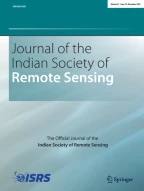Abstract
This paper proposes a new technique to detect the urban slums from urban buildings using very high resolution data. Many cities in the Global South are facing the development and growth of highly dynamic slum areas, but often lack detailed spatial information. Unlike buildings, vegetation and other features, urban slums lack in their unique spectral signatures. Thus, accurate detection of slums using remote sensing data poses real challenge to researchers and decision-makers. In this work, gray-level co-occurrence matrix, Tamura-based statistical feature extraction and wavelet frame transform-based spectral feature extraction techniques are proposed for detecting the urban slums from urban buildings. The very high resolution data of Madurai city, South India, acquired by Worldview-2 sensor (1.84 m) proved the ability of the proposed approaches to identify urban slums from urban buildings. Experimental results demonstrate that the proposed wavelet frame transform-based approach can generate higher classification accuracy than other approaches.
Similar content being viewed by others
References
Alagu Raja, R. A., Anand, V., Senthil Kumar, S., & Abhai Kumar, V. (2009). Wavelet frames based feature extraction technique for improving classification accuracy. Journal of Indian Society of Remote Sensing, 37(3), 423–431.
Bezdek, J. C., Ehrlich, R., & Full, W. (1984). FCM: The fuzzy c-means clustering algorithm. Computer and Geosciences, 10, 191–203.
Filho, M. N. B., & Sobreira, F. (2008). Accuracy of lacunarity algorithms in texture classification of high spatial resolution images from urban areas. The International Archives of the Photogrammetry, Remote Sensing, and Spatial Information Sciences, 36, 417–422.
GOI. (2010). Rajiv Awas Yojana. In Government of India, Press Information Bureau, http://pibmumbai.gov.in/scripts/static.asp. Accessed 30 Mar 2011.
Haralick, R., Shanmugam, K., & Dinstein, I. (1973). Textural features for image classification. IEEE Transactions on Systems, Man, and Cybernetics, 3(6), 610–621.
Hofmann, P., Strobla, J., Blaschkea, T., & Kux, H. (2010). Detecting informal settlements from quickbird data in Rio De Janeiro using an object based approach. International Journal of Engineering Research and Applications (IJERA), 2(3), 221–225.
Kit, O., Lüdeke, M., & Reckien, D. (2012). Texture-based identification of urban slums in Hyderabad, India using remote sensing data. Elsevier, Science Direct, Applied Geography, 32(2012), 660–667.
Kohli, D., Kerle, N., Sliuzas, R. (2012). Local ontologies for object-based slum identification and classification. In Proceedings of the 4th GEOBIA (pp. 201–206).
Mayunga, S. D., Coleman, D. J., & Zhang, Y. (2007). A semi- automated approach for extracting buildings from QuickBird imagery applied to informal settlement mapping. International Journal of Remote Sensing, 28(2009), 2343–2357.
Owen, K. K., & Wong, D. W. (2013). An approach to differentiate informal settlements using spectral, texture, geomorphology and road accessibility metrics. Elsevier, Science Direct, Applied Geography, 38(2013), 107–118.
Shekhar, S. (2012). Detecting slums from quick bird data in pune using an object oriented approach. International Archives of the Photogrammetry, Remote Sensing and Spatial Information Sciences, XXXIX-B8, 8, 519–524.
Tamura, H., Mori, S., & Yamawaki, T. (1978). Textural features corresponding to Visual Perception. IEEE Transactions on Systems, Man, and Cybernetics, 8, 460–473.
UN. (2002). World urbanization prospects; the 2001 Revision: Data tables and highlights. Environment and Urbanization., 14(2), 45–58.
Unser, M. (1995). Texture classification and segmentation using wavelet frames. IEEE Transactions on Image Processing, 4(11), 1549–1560.
Unser, M., & Eden, M. (1989). Multiresolution feature extraction and selection for texture segmentation. IEEE Transactions on Image Processing, 11(7), 717–728.
Acknowledgements
We are very grateful to the provider DigitalGlobe, for providing imagery for research purpose under 8-band proposal scheme.
Author information
Authors and Affiliations
Corresponding author
About this article
Cite this article
Prabhu, R., Alagu Raja, R.A. Urban Slum Detection Approaches from High-Resolution Satellite Data Using Statistical and Spectral Based Approaches. J Indian Soc Remote Sens 46, 2033–2044 (2018). https://doi.org/10.1007/s12524-018-0869-9
Received:
Accepted:
Published:
Issue Date:
DOI: https://doi.org/10.1007/s12524-018-0869-9
